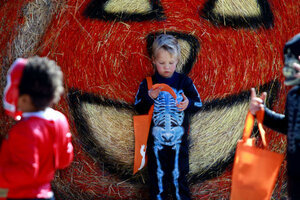Halloween costumes: More sexualized stereotyping for girls
Halloween costumes for kids, particularly girls, are increasingly sexualized, reinforcing the same unhealthy cultural messages about girls' bodies.

Good old-fashioned skeleton costumes – like Cotton Kilian's at the Kansas City (Mo.) Zoo "Boo at the Zoo," Oct. 28 – are harder to find for little girls as even Halloween costumes are increasingly sexualized.
AP
For years, families struck a balance between store-bought and homemade Halloween costumes. But these days, do-it-yourself Halloween costumes are out; store-bought costumes are a $2.87 billion business.
What does this mean for consumers? Well, for one thing, we’re seeing a lot of costumes that reproduce tired gender stereotypes. Sex sells, and in an $8 billion seasonal industry, it seems designers and retailers are maximizing profits by creating more and more “sexy” costumes for women and girls.
In today’s relatively new, hyper-commercial Halloween, it’s become an expectation for females to dress in sexually provocative ways – even when costumed as, say, a children’s cartoon character, like Nemo from "Finding Nemo," or a mundanely macabre item like a body bag. Are you a man? Your body bag Halloween costume will resemble an actual body bag. Are you a woman? The ladies’ version of a body bag costume will be (drum roll…) a skimpy dress with a hood that zips over your head. Seriously.
Adding insult to injury, the definition of “sexy” applied to the majority of women’s Halloween costumes is appallingly narrow. Tiny dresses with a lot of revealed skin available in a very limited range of sizes make it clear: Mainstream, readily-available “sexy” costumes aren’t being made for the full-figured, despite the fact that a size 14 is the average American woman’s size.
The typical sexy Halloween costumes divide women and shortchange young girls by conveying the same old message: If you don’t fit our society’s narrow beauty ideal, this culture doesn’t want to think of you as being sexually desirable. So you’d better focus on your appearance above all else. Note that even the new “sexy” costume for Ursula the Sea Witch from The Little Mermaid is scaled down, available in tiny sizes, even though the original character from the film is a confident, full-figured woman – which seems really incongruous.
Unfortunately, as parents of young girls know, today’s girls’ Halloween costumes are highly sexualized, too. This reinforces the same unhealthy messages about what female bodies are considered desirable and undesirable in our culture.
Although the issue is not just with costumes modeled after sexualized dolls, Bratz and Monster High costumes are a perennial source of concern; several years ago, in her book "The Lolita Effect," Gigi Durham wrote:
"Last Halloween, a five-year-old girl showed up at my doorstep decked out in a tube top, gauzy miniskirt, platform shoes, and glittering eye shadow. The outfit projected a rather tawdry adult sexuality. “I’m a Bratz!” the tot piped up proudly, brandishing a look-alike doll clutched in her chubby fist. I had an instant, dizzying flashback to an image of a child prostitute I had seen in Cambodia, dressed in a disturbingly similar outfit."
RELATED: Top 5 bullying myths - What you don't know about bullying
But, no – even the most inane girls’ costume ideas are rendered in skimpy styles, calculated to be provocative. From sexy witches and sexy vampires to sexy crayons, costumes that encourage young girls to sexualize themselves are everywhere.
No wonder some are complaining that Halloween has turned into “Happy Sexualize our Daughters Season.” Ugh.
The Christian Science Monitor has assembled a diverse group of the best family and parenting bloggers out there. Our contributing and guest bloggers are not employed or directed by the Monitor, and the views expressed are the bloggers' own, as is responsibility for the content of their blogs. Rebecca Hains blogs at rebeccahains.wordpress.com.

